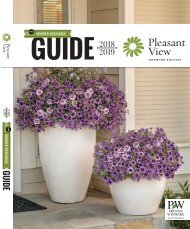- Page 1 and 2:
1976 PVG GROWER RESOURCE GUIDE 2019
- Page 3 and 4:
LEGEND WHAT’S THE LEGEND? As you
- Page 5 and 6:
INTRO PVG 2018 2019 THE PROVEN SUCC
- Page 7 and 8:
NEW FOR 2019 PVG 2018 2019 OUR 40 Y
- Page 9 and 10:
Pumpkin Spice Latte NEW FOR 2019 PV
- Page 11 and 12:
FIRE LIGHT ® Hydrangea NEW FOR 201
- Page 13 and 14:
PROVEN WINNERS ® Annuals NEW FOR 2
- Page 15 and 16:
NEW FOR 2019 PVG 2018 2019 SUPERBEL
- Page 17 and 18:
NEW FOR 2019 PVG 2018 2019 HIPPO ®
- Page 19 and 20:
NEW FOR 2019 PVG 2018 2019 WHIRLWIN
- Page 21 and 22:
NEW FOR 2019 PVG 2018 2019 DALINA
- Page 23 and 24:
NEW FOR 2019 PVG 2018 2019 Cat’s
- Page 25 and 26:
NEW FOR 2019 PVG 2018 2019 BLOOMERA
- Page 27 and 28:
PROGRAM CHANGES & Updates NEW FOR 2
- Page 29 and 30:
2019 DROP LIST RECOMMENDED SUBSTITU
- Page 31 and 32:
LINER GUIDE PVG 2018 2019 YOU COULD
- Page 33 and 34:
LINER GUIDE 6 7 8 9 10 11 12 13 14
- Page 35 and 36:
ENHANCED Liners ENHANCED LINERS T
- Page 37 and 38:
32E VARIETIES ANGELFACE ® Blue Imp
- Page 39 and 40:
72E VARIETIES ANGELFACE ® Blue Imp
- Page 41 and 42:
STREAMLINERS TAG OPTIONS 1. Defaul
- Page 43 and 44:
84 LINER TRAY (84) ANNUALS Liner Si
- Page 45 and 46:
50 DEEP LINER TRAY (50D) »» Large
- Page 47 and 48:
SECOND SEASON COLOR MUM - PINCHED L
- Page 49 and 50:
PREFINISHED GETS YOU READY FOR SPRI
- Page 51 and 52:
ANNUALS VARIETIES 4.25 10HB VARIETI
- Page 53 and 54:
RECIPE GUIDE PVG 2018 2019 THE TRIC
- Page 55 and 56:
Above & Beyond SUPERTUNIA VISTA ®
- Page 57 and 58:
Canterbury SUPERBELLS ® POMEGRANAT
- Page 59 and 60:
Fired Up! GOLDILOCKS ROCKS ® Biden
- Page 61 and 62:
Into The Mystic SUPERTUNIA ® ROYAL
- Page 63 and 64:
Pink Sky SUPERTUNIA ® Blue Skies P
- Page 65 and 66:
Starry Sunset SUPERBELLS ® Yellow
- Page 67 and 68:
Vineyard Blossom SUPERTUNIA ® BORD
- Page 69 and 70:
GO & GROW KITS PVG 2018 2019 WE LI
- Page 71 and 72:
6 KIT PACKAGES GO & GROW CLEMATIS
- Page 73 and 74:
QUICK TURNS, FAST FINISH, HIGHER PR
- Page 75 and 76:
6 STARTER KIT OPTIONS STARTER KIT I
- Page 77 and 78:
24 VARIETIES IN A BOX! GO & GROW K
- Page 79 and 80:
GROW YOUR OWN ADVENTURE. GO & GROW
- Page 81 and 82:
KIT INCLUDES YOUR CHOICE OF RECIPE:
- Page 83 and 84:
GO & GROW CLEMATIS Kit GO & GROW
- Page 85 and 86:
FAVORITES PVG 2018 2019 WE DON’T
- Page 87 and 88:
FAVORITES LADY GODIVA Yellow Calen
- Page 89 and 90:
FAVORITES COLORBLAZE ® Strawberry
- Page 91 and 92:
FAVORITES LADY GODIVA Orange Calen
- Page 93 and 94:
FAVORITES ENDLESS Illumination Bro
- Page 95 and 96:
FAVORITES ANGELFACE ® Cascade Blue
- Page 97 and 98:
FAVORITES FAIRY DUST Pink Cuphea F
- Page 99 and 100:
FAVORITES GOLDILOCKS ROCKS ® Biden
- Page 101 and 102:
FAVORITES SILVER BULLET Artemisia
- Page 103 and 104:
VARIETIES THERE’S SOMETHING WE CA
- Page 105 and 106:
ALTERNANTHERA PLUM DANDY Z: 10-11
- Page 107 and 108:
ANGELFACE ® Perfectly Pink Angelon
- Page 109 and 110:
ANGELONIA ANGELFACE ® Cascade Pink
- Page 111 and 112:
ARGYRANTHEMUM ARTEMISIA ANNUALS A 2
- Page 113 and 114:
BEGONIA tuberhybrida ILLUMINATION
- Page 115 and 116:
BEGONIA tuberhybrida NONSTOP ® Moc
- Page 117 and 118:
BEGONIA ANNUALS B 2018 2019 SUREFIR
- Page 119 and 120:
BIDENS ANNUALS B 2018 2019 GOLDILOC
- Page 121 and 122:
BRACHYSCOME CALENDULA ANNUALS LADY
- Page 123 and 124:
SUPERBELLS ® HOLY COW! Calibrachoa
- Page 125 and 126:
CALIBRACHOA ANNUALS C 2018 2019 SUP
- Page 127 and 128:
TOUCAN ® Dark Orange Canna CALIBRA
- Page 129 and 130:
CATHARANTHUS CHRYSOCEPHALUM ANNUALS
- Page 131 and 132:
CLEOME ANNUALS C 2018 2019 SEÑORIT
- Page 133 and 134:
COLEUS ANNUALS C 2018 2019 COLORBLA
- Page 135 and 136:
COLOCASIA esculenta ROYAL HAWAIIAN
- Page 137 and 138:
CUPHEA ANNUALS C 2018 2019 CUPHEA h
- Page 139 and 140:
DAHLIGHTFUL ® Georgia Peach G13518
- Page 141 and 142:
DAHLIA hybrid DALINA® Midi Series
- Page 143 and 144:
DELOSPERMA nubigenum DAHLIA DRACAEN
- Page 145 and 146:
DIAMOND FROST ® ‘Inneuphdia’ U
- Page 147 and 148:
For Fragaria, see Strawberries page
- Page 149 and 150:
GAURA GOMPHRENA TRUFFULA Pink ANNUA
- Page 151 and 152:
HEDERA HYPOESTES ANNUALS H 2018 201
- Page 153 and 154:
ANNUALS ROCKAPULCO ® ‘Balolestop
- Page 155 and 156:
IMPATIENS ANNUALS I 2018 2019 INFIN
- Page 157 and 158:
IPOMOEA batatas IMPATIENS IPOMOEA A
- Page 159 and 160:
IPOMOEA Sweet Caroline Bewitched GR
- Page 161 and 162:
IPOMOEA ANNUALS I 2018 2019 Sweet C
- Page 163 and 164:
ISOTOMA LAMIUM ANNUALS L 2018 2019
- Page 165 and 166:
LANTANA ANNUALS L 2018 2019 LUSCIOU
- Page 167 and 168:
LANTANA camara BANDANA ® Series Z:
- Page 169 and 170:
LOBELIA ANNUALS L 2018 2019 LAGUNA
- Page 171 and 172:
LOBULARIA ANNUALS L 2018 2019 WHITE
- Page 173 and 174:
LYSIMACHIA NEMESIA ANNUALS Opal INN
- Page 175 and 176:
NEMESIA OSTEOSPERMUM BRIGHT LIGHTS
- Page 177 and 178:
Lemon Symphony ‘Seikilrem’ USPP
- Page 179 and 180:
OXALIS PELARGONIUM BOLDLY ® Dark R
- Page 181 and 182:
ANNUALS PELARGONIUM TIMELESS Orang
- Page 183 and 184:
PETUNIA ANNUALS P 2018 2019 SUPERTU
- Page 185 and 186: SUPERTUNIA ® MINIS ARE NOW NAMED S
- Page 187 and 188: SUPERTUNIA ® Indigo Charm Petunia
- Page 189 and 190: PETUNIA ANNUALS P 2018 2019 SUPERTU
- Page 191 and 192: PETUNIA ANNUALS P 2018 2019 SUPERTU
- Page 193 and 194: PETUNIA PLECTRANTHUS ANNUALS P 2018
- Page 195 and 196: RUELLIA simplex MACHU Morado ’R1
- Page 197 and 198: For Salvia, see Perennials page 247
- Page 199 and 200: SCAEVOLA ANNUALS S 2018 2019 WHIRLW
- Page 201 and 202: SEDUM reflexum 84 Ember Reef Z: 3-1
- Page 203 and 204: SUTERA ANNUALS S 2018 2019 SNOWSTOR
- Page 205 and 206: THUNBERGIA TORENIA ANNUALS T 2018 2
- Page 207 and 208: TORENIA VERBENA ANNUALS SUPERBENA
- Page 209 and 210: SUPERBENA ® Royale VERBENA ANNUALS
- Page 211 and 212: ANNUALS V 2018 2019 VERBENA METEOR
- Page 213 and 214: CYPERUS GRASSES PVG 2018 2019 GRACE
- Page 215 and 216: GRACEFUL GRASSES ® Fiber Optic Gra
- Page 217 and 218: KNOWLEDGE PERSONAL ATTENTION SUPPOR
- Page 219 and 220: PROVEN HARVEST A 2018 2019 AMAZEL
- Page 221 and 222: STRAWBERRY TOMATO PROVEN HARVEST T
- Page 223 and 224: SAVOR EDIBLES & FRAGRANTS Keeping
- Page 225 and 226: MINT ISLAND PINEAPPLE Hardy, pineap
- Page 227 and 228: EGGPLANT Classic Standard black Gre
- Page 229 and 230: TOMATO Gold Nugget Cherry yellow Le
- Page 231 and 232: CLEMATIS hybrids Vernalized, heavil
- Page 233 and 234: Pinky Z: 4-9 HT 6-8' SP 36-48" V: 2
- Page 235: DELOSPERMA DIANTHUS PERENNIALS D 20
- Page 239 and 240: HELIOPSIS HEUCHERA PERENNIALS H 201
- Page 241 and 242: FUN AND GAMES ® Red Rover USPPAF C
- Page 243 and 244: HOSTA PERENNIALS H 2018 2019 SHADOW
- Page 245 and 246: LAMIUM AMAZING DAISIES ® DAISY MAY
- Page 247 and 248: For more Oxalis varieties, see Annu
- Page 249 and 250: PHLOX SALIVIA PERENNIALS S 2018 201
- Page 251 and 252: SEDUM STRAWBERRY PERENNIALS S 2018
- Page 253 and 254: BUDDLEIA x Miss Molly Z: 5-9 HT 48-
- Page 255 and 256: HYDRANGEA arborescens INVINCIBELLE
- Page 257 and 258: LITTLE QUICK FIRE ® Z: 3-8 HT 36-6
- Page 259 and 260: ROSA AT LAST ® Z: 5-9 HT 30-36”
- Page 261 and 262: SAMBUCUS WEIGELA SYRINGA BLOOMERANG
- Page 263 and 264: WE TAKE A NOVEL APPROACH TO ANTICIP
- Page 265 and 266: ® PUT THE PROVEN WINNERS Brand to
- Page 267 and 268: Be a KEY ACCOUNT GROWER SAVE ON FRE
- Page 269 and 270: HELPING IGCs 1. FREE WHOLESALE AND
- Page 271 and 272: ANNUALS 4.25 GRANDE PERENNIALS 4.25
- Page 273 and 274: ORDERING GUIDE PVG 2018 2019 TRUE B
- Page 275 and 276: ONLINE Ordering Visit http://picas.
- Page 277 and 278: 3 SMART SHIP WEEKS SHIPPING OPTIMIZ
- Page 279 and 280: BRANDED CONTAINER Options ALL CLEOM
- Page 281 and 282: TAG ORDERING Options ONE PLANT AND
- Page 283 and 284: GROWER III. SHIPPING RECOMMENDATION
- Page 285 and 286: INDEX SOMETHING YOUR PLANTS NEED MO
- Page 287 and 288:
Variety Description Page Number 32E
- Page 289 and 290:
Variety Description Page Number 32E
- Page 291 and 292:
GRASSES Variety Description Acorus
- Page 293 and 294:
WEEK NO. July 2018 S M T W T F S 27
- Page 295 and 296:
GROWER- ON-CALL The CUSTOMER RELATI
















